Remote controlled unmanned aircraft, commonly known as “drones,” have been approved by the Federal Aviation Administration for use in Alaska. Conoco Phillips received the approval to use the drones to monitor for oil spills and observe wildlife off the Beaufort Sea coast in the Arctic Circle.
Oil Spill Response
Oil spill response in Sound depends on trained fishing vessel crews
In Prince William Sound, fishing vessel crews are trained to help clean up oil spills. These trained responders are familiar with local waters, and can respond quickly to a spill.
Alyeska’s Ship Escort Response Vessel System, or SERVS, oversees the program. SERVS contracts vessels throughout Prince William Sound and downstream areas such as Kodiak, Seward, Homer, Kenai and other smaller communities as part of the program. There are over 400 vessels and their associated crews on contract.
The vessels’ crews attend three days of training each year, including classroom lectures, hands-on experience with equipment, and on-water exercises.
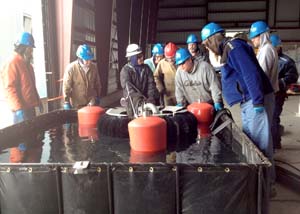
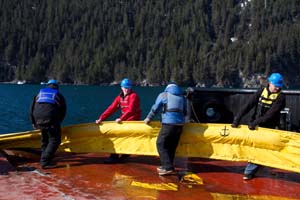
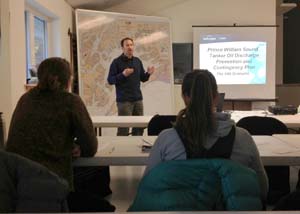
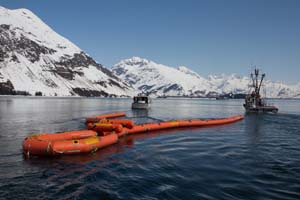
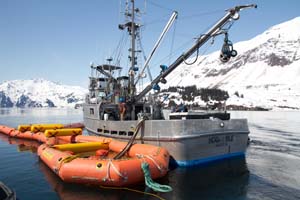
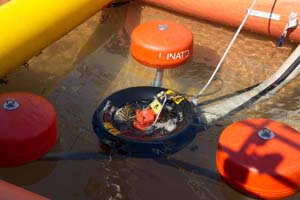
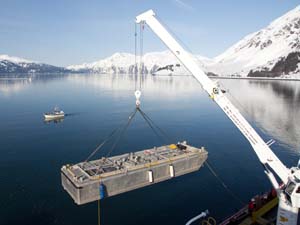
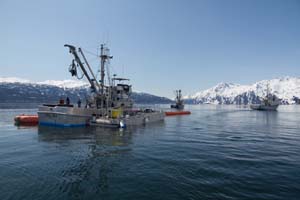
Council and partners work to permit oil spill simulant for response training
By JEREMY ROBIDA
Council project manager
Because evaluating the effectiveness of oil recovery efforts during trainings and drills can be difficult, the council has been working to find an appropriate oil simulant. A simulant would mimic oil on water and provide responders with a practice target and help to increase proficiency with response gear and tactics.
In March, the council partnered with Cordova’s Oil Spill Recovery Institute and the Spill Control Association of America to host a workshop to address this topic. The workshop was held at the Seattle campus of the National Oceanic and Atmospheric Association, or NOAA.
Although the council is interested in improving training locally, the broader goal of the partnership and workshop was to address simulant use on a national level.
Twenty-seven people participated, and the workshop featured two panels that addressed the need for simulants, permitting and other regulatory requirements, and concerns related to their use. The panels were composed of representatives from spill response organizations, NOAA, the Environmental Protection Agency, the Bureau of Safety and Environmental Enforcement, representatives from the U.S. Coast Guard’s National Response Team, and the council, among others.
The workshop concluded with a final group discussion on the next steps for this effort and consensus was reached on a number of items including:
- There is a need for simulants. Some of the possible uses are: a training aid for practice with boom deployment, skimmer testing, recovery of spilled oil in arctic conditions, and tracking spilled oil.
- Different materials have unique characteristics useful for varying goals and conditions. For example, floating wood chips could work for boom practice, but might not be practical for certain skimmers.
- There is a difference between particle based simulants such as wood chips, pine needles or oranges, and liquid based simulants such as fish oil, or vegetable oil. This distinction could complicate the permitting process.
- Raising public awareness of simulants and their benefits to spill response preparedness would be positive.
At the end of the workshop, the group had unanswered questions, such as:
- Can an ongoing blanket permit for certain particle based simulants be achieved?
- Do simulants need to be used in every exercise and deployment?
- Would responders be liable if only a portion of the simulant were recovered?
While the idea seems simple, the issue is complex. Federal and state laws regarding permitting are unclear and full of potential obstacles.
The next stage of the project will be a white paper which will describe the topics and consensus items discussed at the workshop, and next steps. The council hopes that the paper can be presented at an upcoming oil spill response conference. Work continues with the goal of enhancing oil spill recovery efforts in Prince William Sound.
REPORT: The full report is now available on our Oil Simulants project page.
Fall drills and exercises test industry spill response plans
By ROY ROBERTSON
Council Project Manager
This past October 3 and 4, Tesoro conducted the annual large-scale oil spill response exercise to test the Prince William Sound Tanker Oil Discharge Prevention and Contingency Plan.
The scenario imagined that, during inclement weather, an outbound partially loaded tanker struck an unknown object near Glacier Island and suffered a breached hull. The tanker instantaneously released a simulated 20,000 barrels of North Slope crude oil. The vessel sustained no further damage and the bad weather eased as the response continued with no further release of oil.
The first 12 hours of the exercise was led by Alyeska’s Ship Escort/Response Vessel System, or SERVS, as would happen in the case of a real spill.
After 12 hours, Tesoro’s response team took command of the response efforts, with continued help from SERVS.
The main focus of this year’s exercise was to test the following objectives:
• Communications between the command center in Valdez and the field regarding equipment staging and protection of shorelines, nearshore areas, and wildlife
• Logistical support for tracking the operation and resources
• Use of the fishing vessel oil spill response fleet
• Management, staffing, and set-up of equipment staging areas
The drill was a table-top exercise. No equipment or vessels were deployed except for equipment staging areas in Cordova and Whittier.
Council staff participated in various roles and helped evaluate the responders.
Some lessons were noted by the council evaluators:
• Communications between the equipment staging areas and the command post could be improved.
• An actual incident would require more Internet connections and phone lines at the command center.
• The coordination of the wildlife efforts could be improved to insure a more efficient response to the oiled wildlife.
This exercise provided a very good interaction between the industry and agencies’ response teams.
Terminal exercise conducted in November
On November 8, Alyeska conducted an exercise at the Valdez Marine Terminal.
This exercise imagined a 90,000-barrel crude oil spill into the Port of Valdez due to ruptured piping at one of the terminal’s loading berths. The spilled oil moved toward the city of Valdez, so city officials participated as part of the spill response leadership team, known as the Unified Command. Council staff members served as evaluators or as part of the drill team.
This exercise was a precursor to next summer’s National Preparedness for Response Exercise Program, which will be led by the Coast Guard. There was good participation by the Coast Guard and the state agencies in November’s exercise. One of the high points of this exercise was a change in the trajectory from the scenario in the plan that pushed oil toward the city of Valdez.
This caused response actions that focused on protecting the public. Lessons noted by council evaluators included:
• Notifications need to be improved.
• Reorganization of the Valdez Emergency Operations Center made the space more efficient.
• This drill used real time as opposed to the artificial timeframes used in other drills. This made the activities more realistic.
Whittier spill response exercise
On December 7, SERVS conducted an oil spill response exercise in Whittier.
Local fishing vessels, part of the industry’s oil spill fishing vessel response program, participated in the exercise. All the fishing vessels were Tier 1. Tier 1 boats are the earliest responders in case of a spill.
Participants were able to practice tactics such as exclusion and deflection booming. These tactics would be used in case of a real spill, to direct oil away from environmentally sensitive areas.
Council staff was on hand to observe the drill activities.